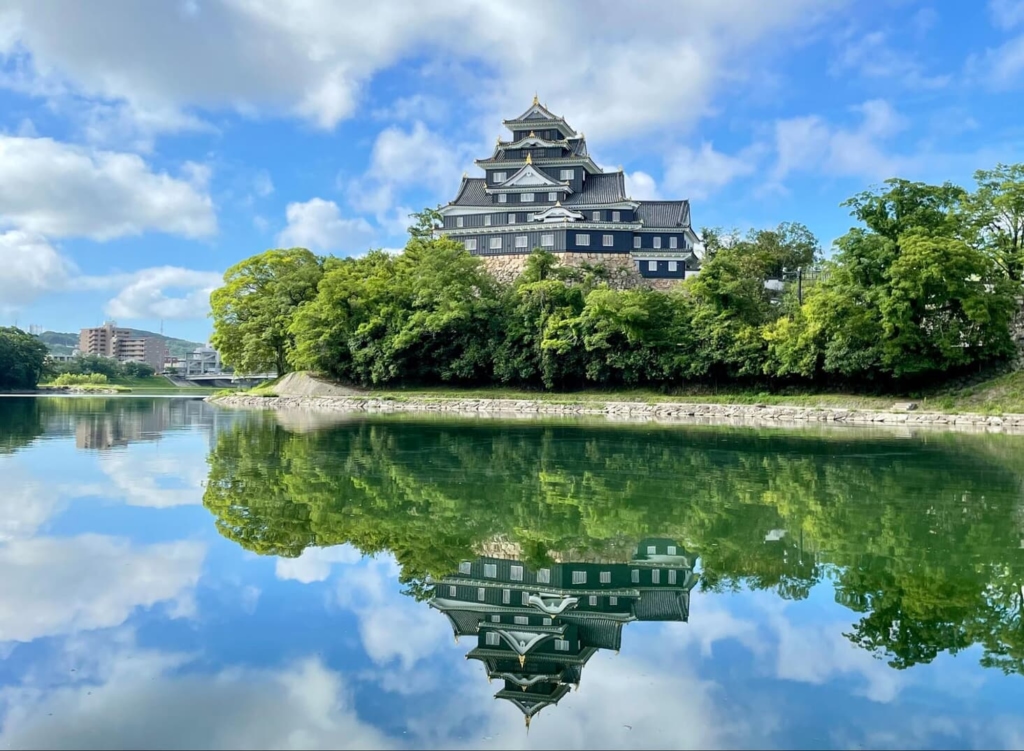Okayama Castle, its outer walls overlaid with striking black clapboard, stands tall on the banks of the Asahi River in Okayama City. Like other Japanese castles, it mesmerizes onlookers, both with its imposing yet elegant design and its promise of a rich and exciting history.
That history is more accessible than ever thanks to the castle’s renewal, which took place over nearly a year and a half between June 2021 and November 2022. The new and improved castle provides better views, easier access and, most importantly, a deeper, more immersive encounter with Okayama’s past.
A Castle Reborn
You’d never guess it from the outside, but Okayama Castle is a replica. The original, completed in 1597, survived for centuries, even managing to remain partially intact following the 1873 Ordinance for the Disposal of Castles that saw many of Japan’s castles dismantled. Though much of the extensive moat and grounds were lost to city growth in the years after the ordinance, several buildings, including the tenshu castle tower, remained. That is, until the air raid of June 29, 1945.
In the ensuing fires, most of what had survived the ordinance and urbanization, including the tower, was lost. Just one original building remains in the honmaru inner citadel area — the Tsukimi Yagura turret, built in 1620 and found in the northwest corner of the castle grounds.
In 1966, the castle was rebuilt using concrete, and since then, it has acted as both a symbol of its namesake city and prefecture and as a repository of the area’s history.

Image courtesy of Okayama City Tourism Promotion Division
A Makeover on the Inside and Out
Far from remaining exactly as it was when completed in 1966, Okayama Castle has seen several updates over the years. In 1996, to commemorate the castle’s 400th anniversary, the shachihoko roof ornaments were gilded, reflecting the more dazzling of the castle’s two nicknames, Kin-Ujo (Golden Crow Castle), originally earned for its gold-leaf roof tiles. The castle’s other nickname, Ujo (Crow Castle), comes from its black clapboard walls.
Okayama Castle’s more recent modifications are of a larger scale. One significant behind-the-scenes improvement — seismic reinforcement to protect against earthquake damage — may not be obvious, but other changes alter the way visitors interact with the castle and its exhibits.
Outside the tower on the castle grounds, the walkways have been paved, a change particularly welcome on rainy days. The castle walls have also received a new coat of paint, intensifying the contrast between the black clapboards and the gilded shachihoko, while the striking ishigaki stone walls are now in plain view and illuminated, along with the tower, after dark.

Image courtesy of Okayama City Tourism Promotion Division
Modern Storytelling
The modifications that will affect a visitor’s experience the most, however, are inside the castle. Particularly helpful for non-Japanese speakers is a smart-phone-enabled system that allows visitors to scan QR codes to access explanations for displays in English, Chinese and Korean.
You’ll find a variety of visually appealing and hands-on exhibits designed to keep everyone interested, from kids and those with little to no background knowledge to history connoisseurs.
Great care went into the creation of each display, with Okayama-native Michifumi Isoda, a history scholar and television personality known for his ability to make complicated subjects accessible to non-experts, overseeing the design process.
Valuable treasures once belonging to important historical figures are exhibited in museum-grade display cases. Films showcase the history of the castle as well as introduce the families that once ruled there, from the Ukita clan that built the castle to the Ikeda clan that constructed the adjacent Korakuen Garden, one of Japan’s three great garden. Projection mapping illustrates in fascinating fashion the origins and growth of the city of Okayama.

Image courtesy of Okayama City Tourism Promotion Division
Hands-on History
The hands-on exhibits are a real treat, though, for when did you ever imagine holding a replica hinawaju (arquebus long gun) to gauge its weight and try aiming? Alongside the hinawaju is a replica katana that can also be held. You can mount a tiny horse too — not a real one, of course, but a life-sized model of an ancient native breed. There’s also a replica palanquin to fold yourself into to get a feel for what it was like to ride in style in the Edo Period (1603–1867).
Those keen to try the Bizen pottery workshop that was offered before the castle closed for renovations will be pleased to know that it’s still available.

Image courtesy of Okayama City Tourism Promotion Division
Old Windows for a Fresh View
Beyond providing you with an overview of Okayama’s history, a visit to Okayama Castle also gives you the chance to enjoy views over the city. From recreated katomado (bell-shaped) windows, admire Korakuen Garden, Asahi River and the modern cityscape that owes its contours to the visions of Okayama’s feudal lords and the development — and destruction — of the castle and its grounds. To understand the modern city, to understand modern Japan, understand its past. The newly reopened Okayama Castle is an excellent starting point.
For more access information, exhibition details and more, visit the official Okayama Castle website.
Sponsored Post









